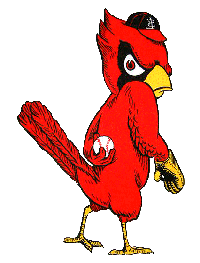
|
Illuminations, Epiphanies, & Reflections
The Von der Ahe
Years
Long before the Cardinals
were the Cardinals, baseball was played in St. Louis. 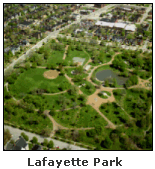 Shepard
Barclay, who was to eventually become a justice on
the Missouri Supreme Court, once recalled that a contractor from "back
east," named Jere Frain, came to St. Louis in the early 1850s.
Along with him, Frain (who had been a ball player with the Charter Oak
Base Ball Nine of Hartford) brought a passion for the new sport.
Unfortunately for Frain, the national craze had not yet reached St.
Louis, so he decided to recruit players himself. Starting from
scratch, he laid out a diamond in Lafayette Park and taught the game
to any of the boys and young men in the neighborhood who were interested. By the mid-1860s, a
handful of amateur baseball clubs had been
founded, including the Red Stockings, the Atlantics, the Empires and
the Unions. Shepard
Barclay, who was to eventually become a justice on
the Missouri Supreme Court, once recalled that a contractor from "back
east," named Jere Frain, came to St. Louis in the early 1850s.
Along with him, Frain (who had been a ball player with the Charter Oak
Base Ball Nine of Hartford) brought a passion for the new sport.
Unfortunately for Frain, the national craze had not yet reached St.
Louis, so he decided to recruit players himself. Starting from
scratch, he laid out a diamond in Lafayette Park and taught the game
to any of the boys and young men in the neighborhood who were interested. By the mid-1860s, a
handful of amateur baseball clubs had been
founded, including the Red Stockings, the Atlantics, the Empires and
the Unions.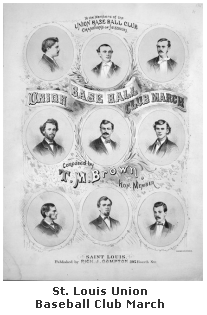
In 1867, the Washington Nationals, a second tier
Eastern
club tired of being beaten to a pulp by the premier New York and
Brooklyn teams, barnstormed across the Midwest leaving a wake of
destruction as it passed cities in Ohio, Indiana, Illinois, and
Kentucky. Newspaper accounts of the trip report incredibly
lopsided defeats of the hastily assembled hometown teams. The
Nationals visit to St. Louis was no exception as they left
town with a resounding 113-26 victory over the most powerful of the
local teams, the Unions. St. Louis, however, was
left with a thirst for more baseball, and amateur clubs flourished in
the city for the the next decade.
In 1874, however, a St. Louis business man, James R. Lucas, announced
that he had raised
$10,000 in capital by selling $50 shares in order to register a team in
the National Association of of Professional Baseball Players, and the following year, the St. Louis Brown Stockings entered the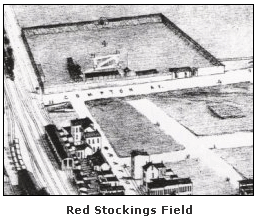 league. Their first game was against a local amateur team, the St. Louis Red Stockings, on 4 May
1875 at the Red Stocking's field on Compton Avenue and Gratiot
Street. Not surprisingly, the Brown Stockings won easily by a score of 15-9. league. Their first game was against a local amateur team, the St. Louis Red Stockings, on 4 May
1875 at the Red Stocking's field on Compton Avenue and Gratiot
Street. Not surprisingly, the Brown Stockings won easily by a score of 15-9.
One of the best teams in the country, the undefeated Boston Red
Stockings, visited St. Louis later that summer sporting a 26 game
winning streak and were surprised by the upstart Brown Stockings at the
old North Grand Avenue baseball field, which in time would become
Sportsman's Park and later Busch Stadium, losing the game 5-4. By
far the biggest game of the year, though, was a home game played
against the Chicago White Stockings, the team that eventually became
the
Chicago Cubs. St. Louis won the game much to the delight of the 5,000 spectators who packed the park
and ended up in fourth place at the end of the year, a respectable
finish for its first year in the league.
In 1876, the team registered to play
as a charter member of the newly formed National League and again did quite well even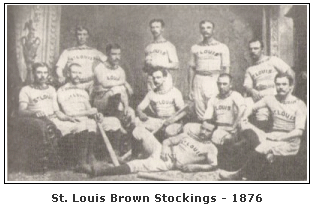 though it had only one pitcher, George Washington "Grin"
Bradley, on its
roster. Bradley, by the way, pitched the first no-hitter in
professional baseball on 15 July, defeating the Hartford Dark Blues
2-0. He pitched every out of every game for the Brown
Stockings that season (535 2/3 innings) and ended with a
45-19 record as the team finished in second place. The League,
however had decided that to determine it's champion, the first and
second place teams would play five additional games against each other
with the winner of the series being christened The Champions of the
West. So, in the first true pre-cursor of the World Series, the
Brown Stockings/Cardinals played the White Stockings/Cubs. St.
Louis easily handled Chicago and won the championship four games to one. though it had only one pitcher, George Washington "Grin"
Bradley, on its
roster. Bradley, by the way, pitched the first no-hitter in
professional baseball on 15 July, defeating the Hartford Dark Blues
2-0. He pitched every out of every game for the Brown
Stockings that season (535 2/3 innings) and ended with a
45-19 record as the team finished in second place. The League,
however had decided that to determine it's champion, the first and
second place teams would play five additional games against each other
with the winner of the series being christened The Champions of the
West. So, in the first true pre-cursor of the World Series, the
Brown Stockings/Cardinals played the White Stockings/Cubs. St.
Louis easily handled Chicago and won the championship four games to one.
The team was
poised for an excellent season the following year
after it lured five superb players away from the Louisville Grays with
very lucrative salary offers. Unfortunately for the Brown
Stockings, four of the five players were implicated in baseball's first
gambling scandal from the season before and banned from baseball for
life. Now without a competitive roster for the year, the
remaining Brown Stockings withdrew from the league and continued to
play as amateurs.
In 1880 a saloon-keeper named Chris
von der Ahe, who owned an establishment near the Grand Avenue ballpark, noticed that business boomed at his tavern on game days when fans poured
in after spending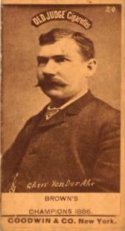 oppressively hot summer afternoons in the uncovered
bleachers. He purchased controlling interest in the nearly defunct amateur Brown Stockings as
well as in the Grand Avenue field, which he renamed Sportsman's Park
and Club. Two
years later, von der Ahe purchased a franchise for his team as one of
the charter members of the old rough-and-tumble American Association,
known as the "Beer and Whiskey League" because of the alleged
rowdiness of its fans and the fact that many of its teams were owned or
sponsored by breweries and distilleries. oppressively hot summer afternoons in the uncovered
bleachers. He purchased controlling interest in the nearly defunct amateur Brown Stockings as
well as in the Grand Avenue field, which he renamed Sportsman's Park
and Club. Two
years later, von der Ahe purchased a franchise for his team as one of
the charter members of the old rough-and-tumble American Association,
known as the "Beer and Whiskey League" because of the alleged
rowdiness of its fans and the fact that many of its teams were owned or
sponsored by breweries and distilleries.
Von der Ahe, a German immigrant, with a larger-than-life
persona and a handlebar moustache to match, referred to himself as
"der Boss President," and he was certainly a good one. Von der
Ahe knew how to make money and billed himself as "The Millionaire
Sportsman." The Browns consistently led the American Association
in attendance and drew in fans with innovations such as on-site beer
sales (balls hit into
the right field beer garden were considered to be
in-play), hotdog vending
(well, sausage vending anyway), and
Sunday games.
Von
der Ahe's team was initially very
successful, compiling a 782-433 (.644) record in its first ten years,
winning the American Association pennant four
times from 1885-1888, and
defeating the National League Champion, the Chicago White
Stockings--now the Chicago Cubs--in the 1885 and 1886 World's
Championship Series.
1888 St. Louis Brown Stockings
The 1885 series was disputed after the fact
by the Chicago owner, Albert
Spalding (yes, that Spalding). In
the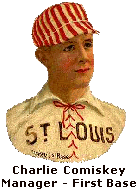 series' second game, the St. Louis player-manger, Charles Comiskey
(yes, that Comiskey) pulled his team off the field in protest of a
botched call by an umpire. The umpires initially decided to call
the game a forfeit, but
the two managers discussed the situation and agreed simply to ignore
the game
and continue the series. When Chicago lost the final game and the
Championship, three games to two, Spalding protested and refused to
allow the prize money--put up by the two owners and held in escrow--to
be
distributed. The only way for Von der Ahe to get his money back
was to submit to Spalding's blackmail and agree that the series was a
tie. series' second game, the St. Louis player-manger, Charles Comiskey
(yes, that Comiskey) pulled his team off the field in protest of a
botched call by an umpire. The umpires initially decided to call
the game a forfeit, but
the two managers discussed the situation and agreed simply to ignore
the game
and continue the series. When Chicago lost the final game and the
Championship, three games to two, Spalding protested and refused to
allow the prize money--put up by the two owners and held in escrow--to
be
distributed. The only way for Von der Ahe to get his money back
was to submit to Spalding's blackmail and agree that the series was a
tie.
Troubles, however, began to mount, beginning in 1887, when Von der Ahe
threatened to deny his players their earnings because of their poor
performance in that year's World's Championship
series. Soon
thereafter,
he dismissed Comiskey and began managing the team himself. The
Brown's performance plummeted, and other legal
problems began to suck
away at his capital. In 1892, when the American Association
folded, the Browns joined the National League, and--hoping
to increase revenue--Von der Ahe moved the team to a sports complex he
built at Vandeventer and Natural Bridge, which he named the New
Sportsman's Park. With a marketing imagination that would not be
equaled until the arrival of Bill Veeck, Von der Ahe constructed "the
Coney Island of the West," which not only contained the ballpark but
included a beer
garden, a chute-the-chute water ride, an outfield track for night time
horse racing, and an
artificial lake. He hired an all female concert orchestra--the
Silver Comet Band--to provide
entertainment by playing popular songs of the day, and used the
facility to host other events, the most
spectacular being a "double-header" that combined a ball game with
Buffalo Bill's Wild West Show when it visited St. Louis after returning
from a European tour. began to suck
away at his capital. In 1892, when the American Association
folded, the Browns joined the National League, and--hoping
to increase revenue--Von der Ahe moved the team to a sports complex he
built at Vandeventer and Natural Bridge, which he named the New
Sportsman's Park. With a marketing imagination that would not be
equaled until the arrival of Bill Veeck, Von der Ahe constructed "the
Coney Island of the West," which not only contained the ballpark but
included a beer
garden, a chute-the-chute water ride, an outfield track for night time
horse racing, and an
artificial lake. He hired an all female concert orchestra--the
Silver Comet Band--to provide
entertainment by playing popular songs of the day, and used the
facility to host other events, the most
spectacular being a "double-header" that combined a ball game with
Buffalo Bill's Wild West Show when it visited St. Louis after returning
from a European tour.
 Unfortunately
his debts continued to mount, and Von der Ahe sold most
of his best players to the Brooklyn Bridegrooms. Subsequently,
after an expensive divorce, he began to resort to loans from shady
characters, and after reneging on one, he was kidnapped and
ransomed. In 1898, a suspicious fire burned New Sportsman's Park
to the ground, and though he rebuilt a much simpler replacement on the
same spot, Von der Ahe eventually lost it and his team in the resulting
civil
trial. Unfortunately
his debts continued to mount, and Von der Ahe sold most
of his best players to the Brooklyn Bridegrooms. Subsequently,
after an expensive divorce, he began to resort to loans from shady
characters, and after reneging on one, he was kidnapped and
ransomed. In 1898, a suspicious fire burned New Sportsman's Park
to the ground, and though he rebuilt a much simpler replacement on the
same spot, Von der Ahe eventually lost it and his team in the resulting
civil
trial.
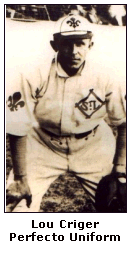 The team then changed owners and names twice
in quick succession, first being rechristened the Perfectos.
Then,
after a sportswriter reported upon a lady's comments about the
interesting shade of red piping on the team's new uniforms, they became
known as the Cardinals. Cleveland street car entrepreneurs, Frank
and Stanley Robinson ended up as team owners in 1899. The
Robinsons also owned Cleveland's National League franchise, the
Spiders, which was doing horribly at the gate. In what amounted
to a near wholesale transfer of players, the Robinsons sent most of
the best Spiders to the Vandeventer Park--which had been renamed
Robinson Field, where they became first
the Perfectos and then the Cardinals. The team then changed owners and names twice
in quick succession, first being rechristened the Perfectos.
Then,
after a sportswriter reported upon a lady's comments about the
interesting shade of red piping on the team's new uniforms, they became
known as the Cardinals. Cleveland street car entrepreneurs, Frank
and Stanley Robinson ended up as team owners in 1899. The
Robinsons also owned Cleveland's National League franchise, the
Spiders, which was doing horribly at the gate. In what amounted
to a near wholesale transfer of players, the Robinsons sent most of
the best Spiders to the Vandeventer Park--which had been renamed
Robinson Field, where they became first
the Perfectos and then the Cardinals.
So, the renamed Cardinals
began their first season in St. Louis with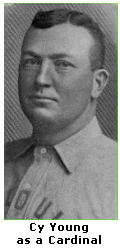 handful of former Cleveland stars filling out the roster
including .400 hitting outfielder Jesse Burkett, super shortstop Bobby
Wallace, and pitcher Denton True "Cyclone"
Young. Interest in the revitalized team was strong, and the
Cardinals played their opening day on 15 April 1899 before a crowd of
18,000 at the rebuilt and renamed League Park on Vandeventer. Cy
Young took the mound on that first game, which was, by coincidence,
with the horrendous Spiders of Cleveland whose roster was filled with
the dregs of the 1898 Brown's team. In less than two hours, Cy
Young and the Cardinals had beaten Cleveland by the score of 10-1. handful of former Cleveland stars filling out the roster
including .400 hitting outfielder Jesse Burkett, super shortstop Bobby
Wallace, and pitcher Denton True "Cyclone"
Young. Interest in the revitalized team was strong, and the
Cardinals played their opening day on 15 April 1899 before a crowd of
18,000 at the rebuilt and renamed League Park on Vandeventer. Cy
Young took the mound on that first game, which was, by coincidence,
with the horrendous Spiders of Cleveland whose roster was filled with
the dregs of the 1898 Brown's team. In less than two hours, Cy
Young and the Cardinals had beaten Cleveland by the score of 10-1.
For a long time, I wondered whatever happened to Chris von der Ahe
after he lost the team and went bankrupt. Recently, I stumbled
upon a copy of his obituary published in the New York Times on 6 June 1913.
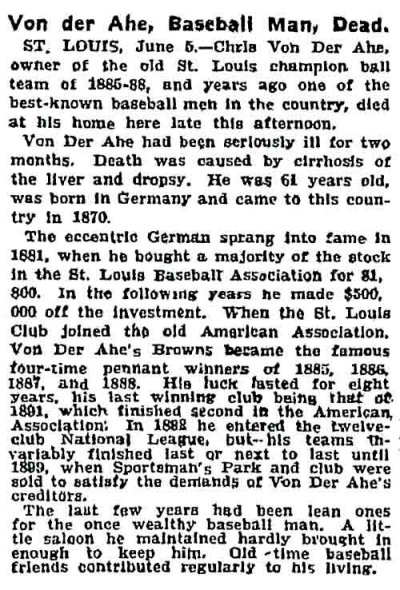 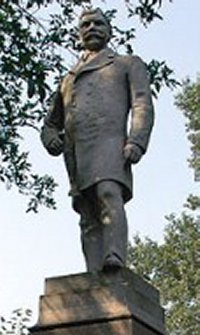
The statue above Von
der Ahe's grave at Bellfontaine Cemetery is one he commissioned to sit
outside the entrance to Sportsman's Park when his Brown Stockings were
in their
prime. At the time, the press ridiculed him for doing so; too bad
this likeness doesn't now stand outside Busch Stadium.
For more
information:
|
|

